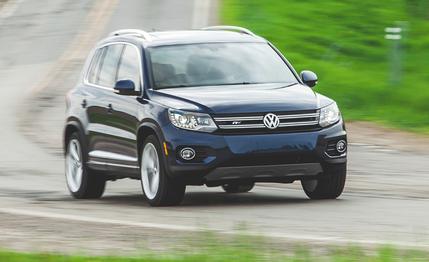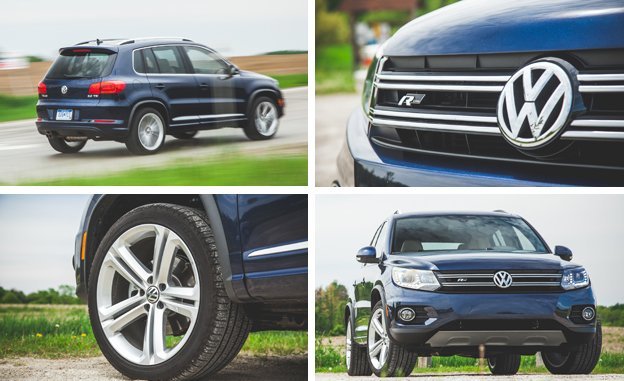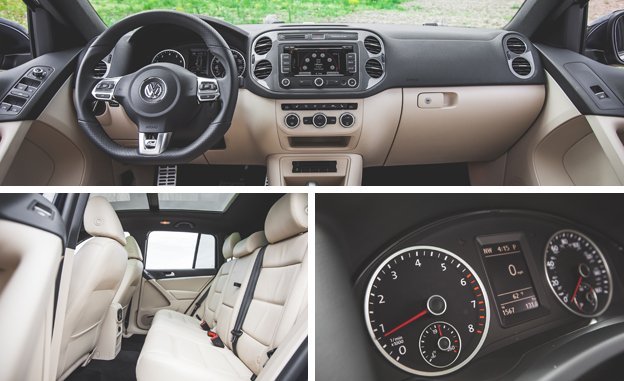
 Instrumented Test
Instrumented Test
As we write these words, Volkswagen is readying the next-generation Tiguan, aiming to add a third row of seats while moving production to Mexico to pare costs. The Tiguan needs a lower price and more room to be competitive in the cutthroat class of compact crossovers. There were fewer players in this segment when the current, German-built model arrived for 2009, sharing its platform with the Mark 5 Golf that was, at the time, called the Rabbit here in the States. So call this test a farewell to the first-gen vehicle with the chimeric name suggestive of a beast that would eat its own platform.
We like to imagine that VW’s marketers were poking a little fun at the whole idea of making a little truck that’s really just a taller car when they created the name, blending the words “tiger” and “iguana.” Today the mashup of car and SUV has become the norm and the Tiguan’s name is about all that sets it apart from the crowd. It placed second in an eight-way comparison in 2010, but the many newer and very good entries arriving since then would make a repeat of that performance improbable. A facelift in 2012 modernized the appearance, but VW never got around to offering America the diesel model it sells in other markets. With the Tiguan already priced at the high end of the segment, VW didn’t see much demand for an even more expensive TDI.


When VW also stopped offering the manual transmission and ignored our suggestion that the DSG, at least, would be a welcome alternative, enthusiast interest waned. That situation is only partially offset by adding the R-Line trim package found on the 2015 model you see here. This is the first time we’ve taken a front-drive Tiguan to the track since that 2010 comparison; another Tiguan test car had 4MOTION, which adds $1975 to most models.
This front-driver weighed 155 pounds less than the 4MOTION edition but 54 more than the comparison-test car, which was a lower-spec SE model. With the same 200-hp 2.0-liter turbo four and six-speed automatic, acceleration was identical to that of the previously tested all-wheel-drive model. The zero-to-60-mph and quarter-mile times of 7.7 and 16.0 seconds each fell about a half-second shy of the 7.1 and 15.5 the front-drive 2010 example posted.
Roadholding matched the other front-driver at 0.79 g, just shy of the 4MOTION car’s 0.81 g. Braking from 70 mph took a disappointing 185 feet and we noted moderate fade. We measured stops 10-feet shorter with less fade in previous tests; one possible explanation is that this car had 19-inch wheels and Pirelli Scorpion Verde all-season tires while the earlier examples had 17-inchers wrapped in Michelin Latitude tires. The “Verde” in the Pirellis’ name may suggest green, low-rolling-resistance priorities, but our observed fuel economy—at 21 mpg—was significantly lower than the 2010 test's 24 mpg.
While we’ve consistently dinged the Tiguan for its high MSRP, real-world shoppers tell us dealers offer aggressive discounts to move the metal. That would certainly make the Tiguan R-Line’s tight fit-and-finish, handsomely dressed interior, and agile handling advantages worth considering. You’d still be settling for less interior room in both the back seat and cargo hold than you’d get from most competitors, however. And, despite a significant and welcome upgrade in the infotainment system for 2015—with more on the way in 2016—this old dog hasn’t learned the popular newer tricks of lane-departure warning, blind-spot monitoring, and automatic cruise control that feature on many more recent arrivals. At least a rearview camera is standard, even on the base S version. The other trim levels, SE and SEL, plus the 4MOTION and Appearance-package variations, add up to eight steps between the $27,120 stripper and the $40,490 R-Line AWD.


The R-Line brings a lot of kit for about $4000 more than a loaded SEL, including a sport suspension, those big wheels, bixenon headlamps, leather seating, a roof spoiler, and lots of extra trim bits (some body color, some aluminum). The only new item on that front this year is that the R-Line’s rear bumper has been restyled.
With the new-generation Golf SportWagen already here offering both a diesel and a manual transmission, plus the upcoming Alltrack variant on the way for 2017, the logic for the Tiguan as it stands today looks ever more dubious even within the VW showroom. Which suggests shoppers might, indeed, find a big discount on a car that’s still more appealing to drive than many newer crossovers, even if it makes no more sense than a furry reptile.